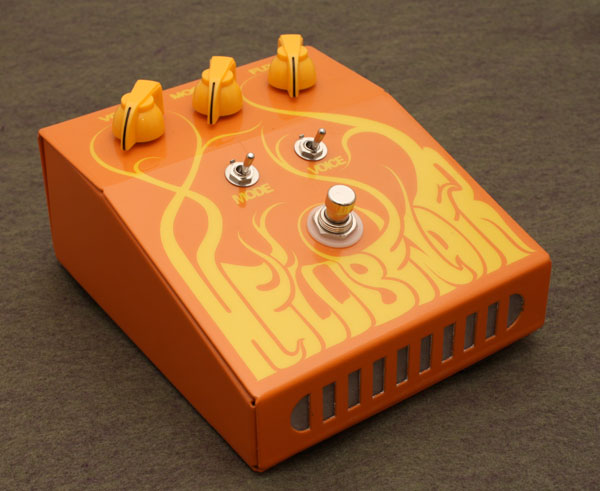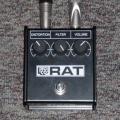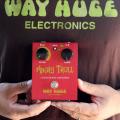 I was psyched to make contact with Deep Trip Pedals. I’ve heard a few people talk about them, so I wanted to see what they were all about. They sent up the Hellbender Fuzz pedal and as usual, I enlisted the help of Jimmy Rolle to help demo the pedal. But first, let’s go into the settings of the fuzz.
I was psyched to make contact with Deep Trip Pedals. I’ve heard a few people talk about them, so I wanted to see what they were all about. They sent up the Hellbender Fuzz pedal and as usual, I enlisted the help of Jimmy Rolle to help demo the pedal. But first, let’s go into the settings of the fuzz.
The Hellbender Fuzz has 3 knobs and 2 toggle switches. The knobs are Vol, Mood and Fuzz. The toggles control Mode and Voice.
Volume is pretty self explanatory. 0 is mute and all the way is wide open.
Mood controls the response dynamics. Changes the gain level, saturation, pick attack, etc.
Fuzz adds the level of fuzz from nice overdrive tones to maximum sustain.
Mode shifts between two modes (2 way toggle). Up position is more ‘vintage’ – fat, dark and slower attack. Down position is more modern, brighter and well defined
Voice (3 way toggle) changes gain/frequency response. Up is fat, heavy and gainy. Middle is bright, clear, edgy and cutting. Down is in between up and middle.
The pedal is true bypass, and initially thought there was no LED (which is fine) but during the demo, noticed that there is a LED inside which makes the ‘grill’ at the front of the pedal light up with a nice amber glow.. nice touch! The enclosure is very bomb proof with the chicken head knobs. Orange and yellow colors.. so it will definitely stand out on any pedal board.
The first demo, Jimmy is playing a American Fender Strat through a Rivera Knucklehead 100 watt head/Marshall 4×12 cabinet. Hellbender is played through the clean channel. The rig was mic’d with a AKG Solidtube and Shure SM57 microphones direct to laptop.
You can also listen to the high quality MP3 via SoundCloud!
This next video is Jimmy playing through the gain channel of the Rivera Knucklehead to see how the Hellbender responds to a high gain amp for leads.
Overall, the Hellbender is a really nice, smooth and creamy sounding fuzz pedal. It is very playable with a variety of tone options. Build construction is outstanding and the ‘look’ is very unique and ye catching.
As with other demos, I also like to interview the builder to see where they’re coming from and to find out more about the pedal and business.
– Where is Deep Trip Pedals from?
Ṣo Paulo, Brazil!РHave you made any pedals for notable artists?
We don’t do any kind of endorsement because we want people to use what they really like, not what some contract says. That means who uses our pedals has bought one, just like anyone else. We do know that some notable Brazilian artists play Deep Trip pedals, like Fred Andrade ( http://www.fredandrade.com/ ), Billy Brandão (sideman for Frejat, Erasmo Carlos etc.), Rob Scrip ( http://www.ageofaquaria.com/ ) and a few session musicians. Most of the pedals we sold abroad were through dealers, so we don’t necessarily have contact with the people who bought and we don’t know who they are. Kinda sad, I’d say, because we really like that kind of interaction.– What would you say is your ‘flagship’ pedal?
Both the Hellbender and the BOG are very popular, the latter because it’s pretty versatile and user friendly (even for those who aren’t used to fuzz pedals). I believe the popularity of the Hellbender lies in the fact that it fills a gap in the market for fuzz pedals that are as dynamic, sensitive and responsive as typical Fuzz Faces, but also have higher gain and sustain. It suits many tones from classic rock side to the metal side (I know that’s odd to say about a modded 60’s circuit, but it is true and proven time and time again). There are a few sensitive and dynamic high gain fuzz pedals on the market, but they are really few.– What did you want to achieve with the Hellbender?
It was born as our modded Colorsound Tonebender mkII, for personal use. The goal was to make a very responsive higher gain fuzz, because we didn’t want to get stuck with those fuzz pedals that have no dynamics whatsoever. In that process we came up with the additional controls to make it versatile and to make it fit perfectly on modern guitar gear. So it can match a Tele for some early Zep, or do some Queens of the Stone Age with humbuckers, or do some nice early Sabbath riffs. And it can wah. And it works with modern transistor amps that don’t usually like fuzz pedals.– What makes the Hellbender stand out?
It has high gain, nice sustain, but it responds to your pick attack and playing dynamics like few high gain fuzz pedals can. And then you can make it cut and pierce, or hammer the gods with it, always keeping your instrument’s character. Just gotta know where to tweak. Oh, and it looks awesome!– What transistors are in the Hellbender? (Silicon or Germanium… and why)
We use three germanium transistors in the fuzz section (that’s what really matters in that Ge x Si talk) and two silicon transistors for other functions. Sixties fuzz designs are very simple, few parts, and that makes them very sensitive to the kind of part you stick there. Our goal never was to replicate the original, so we tested dozens of types to find those which would take us where we wanted. Each stage has a different type of germanium (each one carefully tested and selected) and there’s both new old stock and new production in there. If you change one type or even choose one of the same type with different measurements, it’s not a Hellbender anymore. I mean, it changes A LOT of what that guy is.– How much does the Hellbender cost.. and where do I pick one up?
Right now, we have dealers in Australia ( http://www.deluxeguitars.com.au/deeptrip.asp ) and UK ( http://stores.ebay.co.uk/Tone-Boutique-Guitars ). Everyone else can buy directly from us for US$219 and that includes shipping to Americas and Western/Central Europe. Just e-mail   deeptrip@nulldeeptripland.com and I’ll answer each one personally as fast as I can, as always.
This is a great fuzz pedal. Be sure to check out Deep Trip for other pedals (BOG and Kryptone) at Deep Trip’s website, and follow them on Twitter and Facebook!



